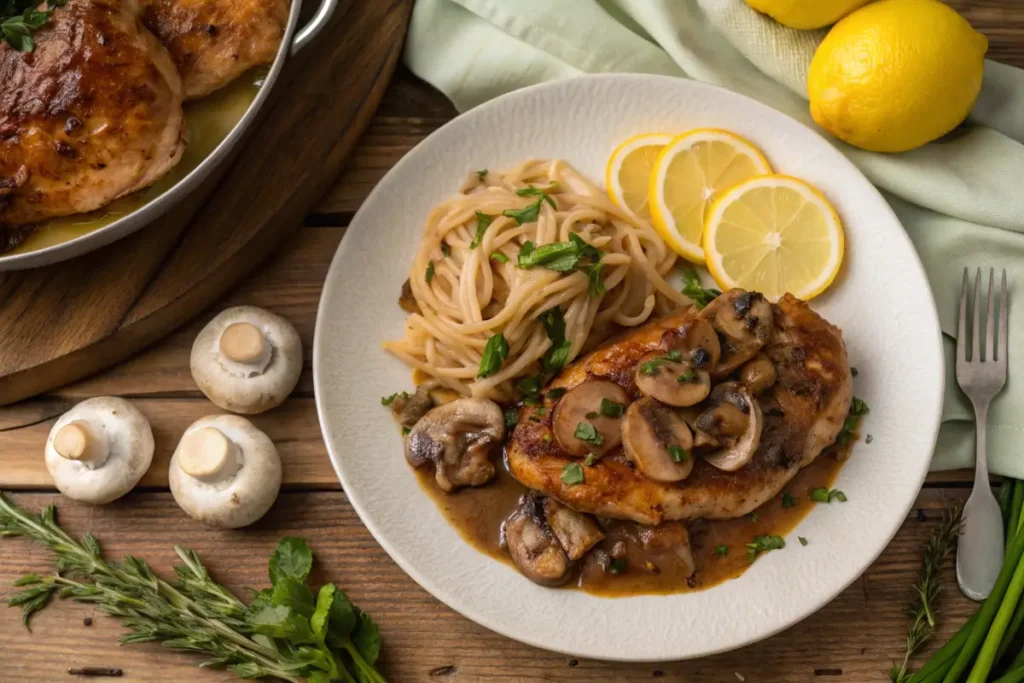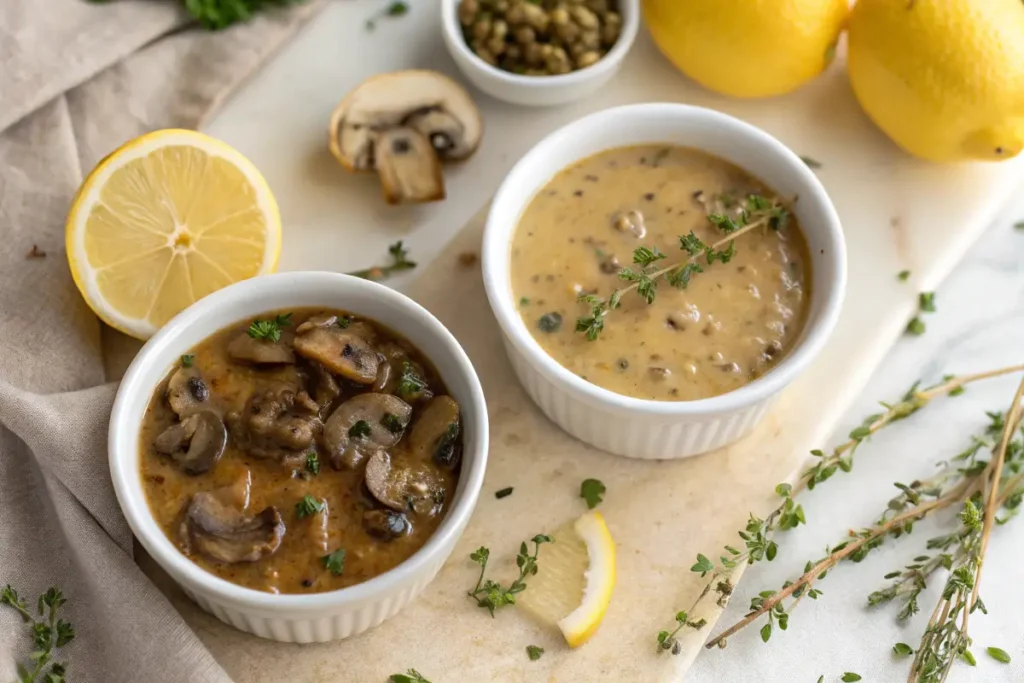Ever wondered what’s the difference between chicken marsala and chicken piccata? This article dives deep into both dishes, shining a light on their unique backgrounds, sauces, cooking methods, and flavors. We’ll also explore nutritional distinctions, serving suggestions, and commonly asked questions. By the end, you’ll have a clear understanding of these Italian chicken dishes plus handy tips to make each recipe a breeze.
Introduction to Chicken Marsala and Chicken Piccata
Understanding the Popularity of These Italian Dishes
Chicken Marsala and Chicken Piccata often top restaurant menus due to their rich histories, delightful flavors, and versatility as Italian chicken dishes. While both feature tender chicken breast and well-balanced sauces, each entrée boasts a distinct charm. Chicken Marsala traditionally relies on sweet Marsala wine sauce and earthy mushrooms, delivering a deeper, slightly caramelized taste. Meanwhile, Chicken Piccata showcases a tangy piccata flavor loaded with zesty lemons, briny capers, and creamy butter.
Moreover, these recipes highlight the magic of simplicity. They don’t require complicated techniques or exotic ingredients—just a few pantry staples to whip up a mouthwatering meal. When paired with sides like creamy mashed potatoes or fresh-roasted vegetables, these dishes become the star of any dinner table. People adore them for their comforting aromas and quick cooking times, which make them perfect for both weeknight family dinners and special occasions.
Why Compare Chicken Marsala and Chicken Piccata?
But what’s the difference between chicken marsala and chicken piccata? For starters, it’s crucial to understand how the sauces differ, as well as the reasons behind each dish’s origins. By comparing key factors—from taste profiles to cooking techniques—you’ll discover which one suits your palate better. Ultimately, exploring these delectable meals broadens your culinary horizons and encourages further experimentation in the kitchen.
Historical Background of Chicken Marsala

The Origins of Marsala Wine
Chicken Marsala owes its distinct taste to Marsala wine sauce, originally crafted in the Marsala region of Sicily. During the late 18th century, English traders recognized the potential of this fortified wine, blending local grapes with brandy for a longer shelf life. As word spread, Italian merchants capitalized on its sweet and robust character, eventually inspiring chefs to pour it into savory mushroom-based sauce for poultry and other meats.
Moreover, the region’s sun-drenched climate and mineral-rich soil helped produce grapes with intense flavors. Thanks to these conditions, the wine’s inherent sweetness complemented sour or earthy notes in various dishes, sparking the idea of marrying it with chicken. In time, Chicken Marsala became a fixture among Italian chicken dishes worldwide, primarily because it infused everyday meals with a dose of Sicilian flair.
Traditional Preparation Methods
Historically, Sicilian cooks relied on fresh herbs, shallots, and mushrooms to heighten the wine’s velvety texture. First, they would lightly dredge chicken breasts in flour to give them a crisp exterior. Next, they’d sauté the chicken until golden before deglazing the pan with Marsala wine. In this process, flavorful brown bits—known as fond—melded into the sauce, producing a truly savory depth.
In addition, some home cooks added a splash of cream for an extra level of richness. Others opted for plain stock instead to keep the dish lighter. Regardless, most recipes demanded a simmering phase that allowed the chicken to soak up every drop of the enhanced savory notes from the sauce. Today, the wine pairing tips and cooking methods remain quite flexible, encouraging modern chefs to tweak spices and garnish with fresh parsley before serving.
Historical Background of Chicken Piccata
Italian Roots and Culinary Influence
Chicken Piccata has roots in classic European cooking that emphasized bright, tangy piccata flavor using lemon and capers. Although “piccata” refers to a thinly sliced or flattened piece of meat sautéed in sauce, many trace its modern popularity to Italian-American kitchens in the 20th century. Nevertheless, the dish takes cues from authentic Mediterranean cuisine, where lemons, olive oil, and fresh herbs were abundant.
Moreover, chefs soon realized that chicken breasts worked wonders in capturing the sharp yet refreshing qualities of the lemon butter sauce. Restaurants showcasing authentic Italian cuisine adopted this approach, pairing the dish with pasta or roasted vegetables for a complete meal. Over time, chefs around the globe embraced Chicken Piccata, showcasing it as an elegant entrée fit for family gatherings or upscale events.
Classic Ingredients and Variations
In its traditional form, Chicken Piccata blends basic yet bold components:
chicken breasts, flour, lemon juice, capers, butter, and a little white wine. However, contemporary recipes often feature additional seasonings like garlic or shallots, giving the dish extra complexity. Every step revolves around balancing zesty, briny, and savory flavors so that no single element overwhelms the rest.
Furthermore, many home cooks experiment with gluten-free flours and low-sodium broths. This flexibility lets people with dietary restrictions enjoy Piccata’s hallmark tang. Interestingly, some variations even swap chicken for fish or veal, yet the core remains. Ultimately, if you’ve ever asked yourself, “What’s the difference between chicken marsala and chicken piccata?”,
remember that the latter focuses on bright citrus, while the former leans on sweet, fortified wine.
Key Distinctions: What’s the Difference Between Chicken Marsala and Chicken Piccata?
Sauce Profiles: Sweet Marsala vs. Tangy Lemon
When comparing these two Italian chicken dishes, we often start with their sauces. Chicken Marsala features a Marsala wine sauce that is slightly sweet, fortified, and sometimes mixed with mushrooms for an enhanced savory note. In contrast, Chicken Piccata spotlights a tangy piccata flavor, driven by lemon juice and capers. This zesty profile adds a bright twist to the buttery sauce, whereas Chicken Marsala’s sauce leans toward caramel-like richness.
Moreover, some cooks add a splash of cream to further thicken Chicken Marsala’s sauce, creating a velvety finish perfect for pairing with mashed potatoes or bread. Meanwhile, the Piccata approach keeps things fairly light, using white wine or chicken stock instead. Thus, if you love a sweet yet bold essence, Marsala may be your go-to. If you prefer a refreshing citric zing, opt for Piccata.
Core Spices, Herbs, and Flavor Notes
Aside from the signature wines, spices and herbs also play a key role in what’s the difference between chicken marsala and chicken piccata? Classic Marsala recipes rely on thyme, onion, or garlic to add depth, ensuring the mushroom-based sauce doesn’t become overly sweet. Conversely, Piccata often employs parsley and garlic, which accent that citrus punch without overshadowing the briny capers.
Furthermore, both dishes embrace a lightly floured chicken breast recipe. Yet Marsala might include more robust seasonings, while Piccata focuses on sharper, tangy edges. Ultimately, small tweaks—like adding chili flakes or substituting gluten-free flour—allow both Chicken Marsala and Chicken Piccata to evolve, maintaining their status as classic and modern variations of a versatile chicken entree.
Flavor and Texture Comparisons
Creamy vs. Light Sauce Consistencies
At first glance, Chicken Marsala can appear creamier due to the addition of dairy or reduced stock. This process creates a luxurious mouthfeel that clings to the chicken, offering a robust experience. In contrast, Chicken Piccata keeps a thinner consistency, relying on lemon juice, capers, and butter to highlight its creamy vs. citrusy contrast. Because Piccata typically avoids heavy cream, it appeals to those who enjoy a lighter sauce that won’t weigh them down.
Furthermore, this contrast impacts each dish’s appearance on the plate. While Marsala can look dark and slightly opaque, Piccata maintains a golden, translucent surface. Whether you pair them with pasta or vegetables, both versions provide lively flavor shifts that elevate any meal.
Mouthfeel and Savory Highlights
Although they’re both traditional Italian cuisine, they deliver distinctly different sensations. Chicken Marsala’s density stems from its enhanced savory notes, often courtesy of caramelized onions or mushrooms. Meanwhile, Chicken Piccata entices with a bright, salty punch, thanks to the combination of lemon and capers.
However, both remain crowd-pleasers for good reason. They start with tender chicken cutlets and finish with sauces that cradle every bite. So the next time you wonder, “What’s the difference between chicken marsala and chicken piccata?” remember that each dish offers unique textures, from Marsala’s velvety richness to Piccata’s lively tang.
Nutritional Differences of Chicken Marsala and Chicken Piccata
Calorie, Protein, and Fat Breakdown
Many people ask, “What’s the difference between chicken marsala and chicken piccata?”—and part of the answer lies in their nutritional content. Despite using similar lean chicken breasts, the extra ingredients can shift calories and fats. Chicken Marsala might carry a slightly higher calorie count because of its Marsala wine sauce and potential use of cream. Meanwhile, Chicken Piccata keeps things moderate, though butter still contributes some fat.
However, both entrées remain solid protein sources, providing essential amino acids. With lean poultry at the center, you’ll usually get a comparable amount of protein in both dishes. In fact, these Italian chicken dishes can fit into a balanced diet if portion sizes stay reasonable.
Dietary Considerations
In addition, people with special diets should pay attention to sauce components. Those aiming to cut saturated fat might prefer Chicken Piccata, especially if they use minimal butter. However, substituting reduced-fat cream in Chicken Marsala can yield a lighter option. Moreover, cooks can swap wheat flour for gluten-free alternatives in either recipe, broadening their appeal.
Ultimately, if you crave intense mushroom-based sauce, don’t hesitate to go with Marsala. Conversely, if you enjoy a tangy piccata flavor with lemon and capers, Piccata is your best bet. Both remain versatile enough to suit a range of dietary considerations, proving that small choices make a big difference.
Part 7: Cooking Tips for Chicken Marsala and Chicken Piccata
Best Practices for a Perfect Sauce
Every chef trying to master Chicken Marsala or Chicken Piccata knows the sauce can make or break the dish. First, remember to sear the chicken quickly over medium-high heat. That method locks in moisture and helps create the fond—those browned bits bursting with flavor. Next, deglazing the pan with wine or stock lifts these savory remnants into your sauce. In Chicken Marsala, use sweet Marsala wine sauce with mushrooms for a robust taste, and let it simmer gently so the flavors fuse.
On the other hand, when crafting a lemon butter sauce for Chicken Piccata, keep the heat moderate and add lemon juice toward the end to preserve its zing. Meanwhile, whisking melted butter into reduced stock or wine helps maintain a silky consistency. Moreover, tasting and adjusting salt levels during cooking ensures you don’t overpower the dish, especially given how capers contribute a salty note to Piccata.
Suggested Cooking Equipment and Tools
Although neither recipe demands fancy gadgets, having the right utensils can enhance your success. A heavy-bottomed skillet distributes heat evenly, preventing scorch marks. Moreover, a sturdy spatula or tongs will help you flip chicken cutlets with ease, reducing the risk of tearing the meat. In addition, a small whisk is excellent for blending sauce ingredients smoothly.
If you’re curious about what’s the difference between chicken marsala and chicken piccata?, try experimenting with both in the same skillet. Start by preparing Chicken Marsala, then wipe out the pan and make Chicken Piccata. This way, you’ll see firsthand how each sauce forms under similar conditions. Finish off with a tasting session to compare flavors. Then, use these cooking tips and techniques to perfect each recipe, ensuring an authentic Italian meal that suits your palate.
Serving Suggestions for Chicken Marsala vs. Chicken Piccata
Ideal Side Dishes and Pairings
When deciding what’s the difference between chicken marsala and chicken piccata?, it helps to look at serving choices. Chicken Marsala, with its Marsala wine sauce and mushroom-based sauce, pairs beautifully with creamy mashed potatoes or buttered noodles. These starchy sides absorb the sweet, savory notes, creating a cozy, satisfying meal. Meanwhile, fresh steamed broccoli or asparagus add color and nutrition without overshadowing Marsala’s rich flavor.
On the other hand, Chicken Piccata’s tangy piccata flavor stands out when you serve it with simple pasta tossed in olive oil and garlic. The bright acidity from the lemon sauce lifts the dish, so milder sides help maintain harmony. In addition, roasted or sautéed vegetables complement Piccata’s zesty bite, balancing its lemony essence.
Recommended Wine Companions
Pairing the right wine can also enhance your dining experience. For Chicken Marsala, a glass of light-bodied red or medium-bodied white works well. Many people opt for an off-dry Riesling to complement the sweetness of the Marsala sauce. Alternatively, a dry sherry or mellow Pinot Noir can highlight the earthy mushroom tones.
For Chicken Piccata, crisp whites like Sauvignon Blanc or Pinot Grigio emphasize the lemon’s tang. Some prefer a Chardonnay with restrained oak, helping weave buttery notes into the sauce. Ultimately, both Chicken Marsala and Chicken Piccata offer room for exploration, so feel free to experiment with different wine styles.
Common Mistakes When Preparing Chicken Marsala or Chicken Piccata
Avoiding Overly Thick Sauces
A frequent blunder involves reducing the sauce too much, leading to an unappealing paste. Although Chicken Marsala can handle a thicker consistency, it should still flow smoothly. Consequently, adding a touch of chicken stock or a splash of water while simmering can rescue your sauce if it becomes gummy. Likewise, Chicken Piccata’s lemon butter sauce may turn overly thick or oily if you simmer it for too long. Keeping an eye on heat levels and monitoring thickness helps avoid a clumpy result.
Ensuring Balanced Flavors
Moreover, balance remains key for both recipes. When making Chicken Marsala, be mindful not to overpower the dish with too much Marsala wine sauce or mushrooms. A hint of sweetness is ideal, but too much can drown out other savory elements. Meanwhile, Chicken Piccata needs a precise measure of lemon juice and capers. If you dump in too many capers, the sauce may become overwhelmingly salty or bitter.
Ultimately, what’s the difference between chicken marsala and chicken piccata? It’s more than just comparing sweet and tangy sauces. Each dish relies on careful measurements and steady heat to produce the ideal taste. Paying attention to these common mistakes guarantees a more enjoyable meal and shows why each dish has earned its place in classic Italian cuisine.
FAQs

Which Dish Is Healthier?
Many people wonder what’s the difference between chicken marsala and chicken piccata? in terms of health. Generally, Chicken Piccata may be slightly lighter since it uses a tangy piccata flavor featuring lemon juice and minimal cream. In contrast, Chicken Marsala often includes Marsala wine sauce and might add cream or mushrooms, increasing calories and fat. Nevertheless, both can fit a balanced diet if you watch portion sizes and use lean chicken breasts.
Can I Substitute Pork or Veal?
Yes, you can. Although pork or veal won’t taste exactly the same, they still deliver savory notes in these Italian chicken dishes. Pork chops pair well with sweet Marsala sauce, while veal cutlets highlight that bright lemon punch in Piccata. Adjust cooking times as needed to ensure each cut reaches a tender, juicy texture.
How Do I Make a Gluten-Free Version?
To craft a gluten-free option, simply swap all-purpose flour for a gluten-free substitute or cornstarch. Everything else stays the same, so you still achieve a crisp coating on the meat. Likewise, verify the wine or stock you use is gluten-free, and you’re all set.
Are Both Dishes Authentic Italian Cuisine?
Both dishes stem from Italian influences yet have become staples in Italian-American dining. While authentic recipes vary across Italy, Chicken Marsala and Chicken Piccata remain widely recognized, blending traditional Mediterranean elements with modern Western touches.
Conclusion
Final Thoughts on Chicken Marsala vs. Chicken Piccata
Ultimately, what’s the difference between chicken marsala and chicken piccata? Each dish captures its own charm through distinct sauces: Marsala’s sweet and earthy vibes versus Piccata’s fresh, lemony sparkle. They share basic ingredients like chicken breasts and sautéed aromatics but carry different flavor balances.
Whether you’re a fan of creamy, mushroom-based sauce or prefer a lighter citrus kick, both entrées stand out as versatile Italian favorites. Moreover, experimenting with various seasonings, side dishes, and wine pairings ensures you’ll never get bored. Enjoy each dish’s unique taste and don’t hesitate to tweak recipes to match your personal preferences.
- Discover why your chicken becomes rubbery in the crock pot and how to fix itUse this link when discussing cooking methods or troubleshooting common chicken dishes.
- Understand cake portions and proper cutting techniquesIdeal for sections related to dessert serving sizes or presentation tips.
- Why petite size cakes are perfect for your next family gatheringGreat for parts of the article that discuss serving options for different occasions.
- Find the perfect mini cake size for any occasionBest used when mentioning smaller dessert options or customizable servings.
- How to reduce cake baking time with smaller cake sizesPerfect for sections offering time-saving cooking tips or efficient baking strategies.






